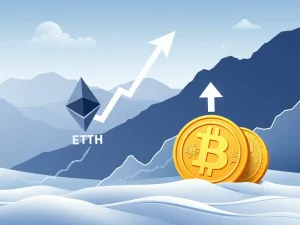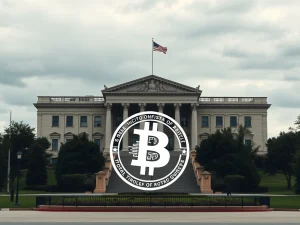Stablecoin Surge: 5 Key Initiatives Accelerating Crypto Adoption

Are you seeing stablecoins everywhere lately? You’re not alone. **Stablecoin** adoption is rapidly gaining traction across the globe. This surge is happening as businesses and individuals become more comfortable with the evolving legal landscape around cryptocurrencies. With increasing institutional interest and moves towards clear regulatory frameworks, the stablecoin market is set for significant expansion.
Why Stablecoin Adoption is Growing
The primary driver behind increased **stablecoin** use is regulatory clarity. In the EU, the Markets in Crypto-Assets (MiCA) package provides clear rules for issuers entering European markets. In the US, proposed legislation like the STABLE Act and the GENIUS Act are working their way through Congress, aiming to establish similar frameworks.
This push for regulation is encouraging major financial players. Payment giants like Mastercard and Visa are enhancing support for stablecoin systems. New stablecoins are launching, boosting the overall market capitalization. Let’s look at five major initiatives projected to accelerate **crypto adoption** through stablecoins.
Tether Eyes Relaunch with a Tether US Coin
Stablecoin leader Tether is reportedly planning a relaunch specifically for the US market with a dollar-based stablecoin. Tether’s existing USDt (USDT) is the largest stablecoin globally, essential for providing liquidity across numerous crypto exchanges.
However, Tether has faced scrutiny regarding reserve transparency and compliance. CEO Paolo Ardoino mentioned plans for a distinct US-focused coin, separate from its international offering. This strategic move could provide Tether access to US financial markets as crypto integration grows, potentially under a more crypto-friendly administration.
Donald Trump’s Involvement and USD1
In an interesting development, World Liberty Financial (WLFI), a project linked to the Trump family, launched its dollar-backed stablecoin, USD1, on the BNB Chain and Ethereum. This coin quickly reached over $2 billion in market capitalization.
USD1 follows other crypto projects leveraging the former president’s brand. His connection to the project has raised questions, with some US senators calling for an inquiry into potential conflicts of interest regarding his ability to influence stablecoin policy.
The Rise of Bank Stablecoin Issuance
Traditional financial institutions are also entering the space. Two US banks, Custodia Bank and Vantage Bank, partnered to issue what they claim is the first bank-issued stablecoin in the US, UK, and Europe. On March 25, Custodia tokenized US dollar demand deposits on Ethereum as an ERC-20 token named Avit.
Custodia CEO Caitlin Long describes Avit as a ‘real dollar’ because it represents funds customers can withdraw on demand, similar to checking account deposits. This development signifies a significant step towards mainstream financial integration for **bank stablecoin** technology.
Stripe Tests a Payments Stablecoin Product
Global payments platform Stripe is developing a US-dollar-based stablecoin product for use outside the US. This follows their acquisition of the stablecoin payments network Bridge in a deal completed in February 2025. Bridge was founded by former Coinbase executives and aims to compete with traditional systems like SWIFT.
This stablecoin initiative is part of Stripe’s broader re-engagement with crypto, which began in 2021 after an earlier pause. They previously added USDC support for users in 70 countries in late 2024, demonstrating their commitment to integrating **payments stablecoin** options.
UAE’s Largest Bank Launches Dirham Stablecoin
In the UAE, a partnership between International Holding Company, Abu Dhabi Developmental Holding, and First Abu Dhabi Bank (FAB) is set to launch a dirham-backed stablecoin. FAB, the UAE’s largest bank, will issue the stablecoin on the ADI network, pending central bank approval.
This initiative aims to significantly impact finance, commerce, and trade within the UAE, highlighting the global nature of stablecoin adoption extending beyond just dollar-pegged assets.
Payments Firms Embrace Stablecoins
Beyond new issuances, established payment networks are adding support. Mastercard partnered with OKX to expand stablecoin card options. Visa collaborated with Stripe and Bridge to offer stablecoin payments in Latin America, starting with several countries. Japanese financial conglomerate SBI is also preparing to add USDC support, pending local regulatory approval, becoming one of the first in Japan to offer USDC trading.
Regulators and payment providers worldwide are increasingly receptive to stablecoins. While US bills are pending, successful frameworks could unlock a large financial market with clear guidelines, further boosting **crypto adoption**.
Conclusion: A Future Built on Stablecoins?
The stablecoin landscape is evolving rapidly. From major players like Tether strategizing for the US market to banks issuing their own tokens and payment giants integrating stablecoin options, the trend is clear. Regulatory clarity is paving the way for wider acceptance and use. As these initiatives mature and more frameworks are established, stablecoins are poised to play a crucial role in connecting the traditional financial system with the growing world of crypto, driving adoption forward.










